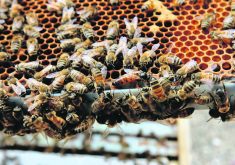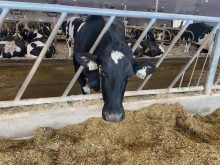Livestock producers are still in the dark on incoming changes to the list of approved veterinary drugs they may source from the U.S.
Health Canada is tightening regulations on own-use importation, a practice allowing producers to buy approved drugs in the United States and carry them into Canada.
As of Nov. 13, that list of approved drugs will change. The new list is incoming, Health Canada says, but has yet not been released.
Own-use imports were a handy tool for beef producers to keep costs down when a drug was approved and available on both sides of the border, said Brian Lemon, Manitoba Beef Producers general manager, who noted the U.S. version of the drugs was frequently significantly lower cost. Now those measures are up in the air, he told the Co-operator.
Read Also

Beekeepers want financial protection against tropi mite
What happens to beekeepers if the deadly tropi mite reaches Canada? Discover why farmers want robust compensation to protect pollination.
“The issue here is that list of drugs where that was available to producers was being redone,” Lemon said. “Basically, the industry had to re-apply, so they wiped everything off the list and the industry had to re-apply to get items put back on the list.”
Producer groups or individuals may petition for a drug to be included. Prescription drugs do not qualify, according to Health Canada, nor do drugs meant to be blended with animal feed or any that contain “medically important antimicrobials” (drugs deemed important for human use). Likewise, the drug must be approved in its home country, have maximum residue limits set in Canada, have a comparable drug approved in Canada and have no unresolved safety issues in either its home country or Canada.
The beef industry is one of several sectors expected to feel the impact of the new rules, which will affect any food-producing animals or animals bound for human consumption, as well as horses.
The Manitoba Beef Producers has been told there will be no gap between the old list expiring and the new list coming into effect, Lemon said.
More in 2018
The move is part of national efforts against antimicrobial resistance (AMR), the fear that critical human medications are becoming less effective against adapting bacteria.
The World Health Organization (WHO) has already raised the alarm, citing concern that increased resistance may cause treatment to become ineffective against a range of diseases (including tuberculosis, HIV and malaria) and cause problems with organ transplants, chemotherapy and surgeries, among other issues. The WHO estimates about 480,000 cases of antibiotic-resistant tuberculosis appear each year across the world, while several countries have noted increased resistance in E. coli, leading to ineffective treatment in more that half of diagnosed urinary tract infections in those regions.
The problem has been linked to overprescription in human medicine, although agriculture has also felt the push to cut down on antibiotic use.
Canadian plan
In 2015, Canada threw support behind the WHO’s Global Action Plan on Antimicrobial Resistance. As part of that, the federal government committed to develop its own national action plan.
“Tackling Antimicrobial Resistance and Antimicrobial Use: A Pan-Canadian Framework for Action” was released in September.
Agriculture has already begun to move on tighter antimicrobial policy, driven by social, market and trade pressures, the report noted.
“To address the challenges of AMR, effective treatments and management approaches must be further implemented to demonstrate appropriate use of antimicrobials in order to ensure the health and welfare of animals, preserve and ensure a safe food supply and keep livestock producers competitive,” the document reads, in part.
“It’s all related to the scare on the human health side of things where some important drugs are increasingly becoming less and less effective,” Lemon said. “Across the board, many of the same drugs that are used in animal agriculture are used in human health and so it’s really about really trying to put more rigour around the use of those important drugs.”
Health Canada estimates that 73 per cent of drugs prescribed for animals are also used for humans.
Sector impacts
The Chicken Farmers of Canada is partway through its three-phase plan to limit antibiotics. In 2014, the organization phased out Category 1 antibiotics, those considered the most critical for human health. High- and medium-importance antibiotics will be phased out over the next three years, leaving farmers access to only low-importance drugs by 2020.
Beekeepers have also come up against the issue. Apiarists in Manitoba and in other provinces have protested incoming rules, which would require them to have a veterinarian prescription for certain antibiotics.
Allan Campbell of the Manitoba Beekeepers’ Association expressed concern earlier this year, citing veterinarians’ relative lack of beekeeping knowledge.
“Virtually every veterinarian knows nothing at all about bees, so on the one hand, yeah, they know drugs; they know antibiotics, but if they don’t know the animal, then it’s kind of disturbing,” he said.
The beef industry will come up against a similar dilemma. As of Dec. 1, 2018, any medically important antimicrobials, including in-water drugs or medicated feed, will need to be checked off by a veterinarian.
Labels will no longer mention a drug’s use for growth promotion or related instructions, while responsible use statements will be added.
“I don’t think at the end of the day it’s going to have a huge impact on the industry. That’s what we’re hearing,” Lemon said. “It’s going to take some time to figure out and let the dust settle. For those producers who maybe didn’t have regular relationships with a vet, it’s going to require that they establish relationships with vets and have a vet on-side that can come out and do the herd health and be comfortable to actually write the prescription.”
















